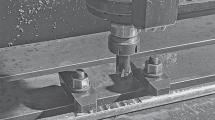Abstract
In this work, a back propagation neural network model has been developed for the prediction of surface roughness in turning operation. A large number of experiments were performed on mild steel work-pieces using high speed steel as the cutting tool. Process parametric conditions including speed, feed, depth of cut, and the measured parameters such as feed and the cutting forces are used as inputs to the neural network model. Roughness of the machined surface corresponding to these conditions is the output of the neural network. The convergence of the mean square error both in training and testing came out very well. The performance of the trained neural network has been tested with experimental data, and found to be in good agreement.




Similar content being viewed by others
References
Albrecht AB (1956) How to secure desired surface finish in turning operations. American Machinist 133–136
Ansell CT, Taylor J (1962) The surface finishing properties of a carbide and ceramic cutting tool. In: Proceedings of the 3rd international MTDR conference
Chandiramani KL, Cook NH (1964) Investigations into the nature of surface finish and its variation with cutting speed. Trans ASME J Eng Ind 86–87:134–140
Karmakar A (1970) Factors influencing surface finish during fine turning. In: Proceedings of 4th all India machine tool design and research conference, pp 123–128
Selvam MS (1975) Tool vibrations and its influence on surface roughness in turning. Wear 35:149–157
Sundaram RM, Lambert BK (1981) Mathematical models to predict surface finish in fine turning of steel. Int J Prod Res 19:547–564
Mital A, Mehta M (1988) Surface finish prediction models for fine turning. Int J Prod Res 26(12):1981–1876
Shiraishi M, Sato S (1990) Dimensional and surface roughness controls in a turning operation. Trans ASME J Eng Indus 112:78–83
Rangwala SS, Dornfield DA (1989) Learning and optimization of machining operations using computing abilities of neural networks. IEEE Trans Sys Man Cybern 19(2):299–214
Azouzi A, Guillot M (1990) On-line optimization of turning process using an inverse process neuro controller. Trans ASME J Manuf Sci Eng 120:101–108
Fang XD, Jawahir IS (1994) Predicting total machining performance in finish turning using integrated fuzzy-set models of the machinability parameters. Int J Prod Res 32(4):833–849
Grezsik W (1996) A revised model for predicting surface roughness in turning. Wear 194:143–148
Thomas M, Beauchamp Y, Youssef AY, Masounave J (1996) Effect of tool vibrations on surface roughness during lathe dry turning process. Comput Ind Eng 31(3/4):637 – 644
Abouelatta OB, Madl J (2001) Surface roughness prediction based on cutting parameters and tool vibrations in turning operations. J Mater Process Technol 118:269–277
Lee BY, Tarng YS (2001) Surface roughness inspection by computer vision in turning operations. Int J Mach Tools Manuf 41:1251–1263
Lin WS, Lee BY, Wu CL (2001) Modeling the surface roughness and cutting force for turning. J Mater Process Technol 108:286–293
Ho SY, Lee KC, Chen SS, Ho SJ (2002) Accurate modeling and prediction of surface roughness by computer vision in turning operations using an adaptive neuro-fuzzy inference system. Int J Mach Tools Manuf 42:1441–1446
Grezsik W, Brol S (2003) Hybrid aprroach to surface roughness evaluation in multistage machining processes. J Mater Process Technol 134:265–272
Puertas-Arbizu I, Luis-Pérez CJ (2003) Surface roughness prediction by factorial design of experiments in turning processes. J Mater Process Technol 143–144:390–396
Risbood KA, Dixit US, Sahasrabudhe AD (2003) Prediction of surface roughness and dimensional deviation by measuring cutting forces and vibrations in turning process. J Mater Process Technol 132:203–214
Lee SS, Chen JC (2003) On-line surface roughness recognition system using artificial neural network system in turning operations. Int J Adv manuf Technol 22:498–509
Kohli A, Dixit US (2004) A neural-network-based methodology for the prediction of surface roughness in a turning process. Int J Adv Manuf Technol 25:118–129
Monostori L (1993) A step towards intelligent manufacturing: modelling and monitoring of manufacturing processes through artificial neural network. Ann CIRP 42(1):485–493
Das S, Roy R, Chottopadhyay AB (1996) Evaluation of wear of turning carbide inserts using neural network. Int J Mach Tools Manuf 36:789–797
Dimla DE, Lister JPM, Leighton NNJ (1997) Neural network solutions to the tool condition monitoring problem in metal cutting-a critical review of methods. Int J Mach Tools Manuf 37(9):1219–1241
Choudhury SK, Jain VK , Rama-Rao CHVV (1999) On-line monitoring of tool wear in turning using neural network. Int J Mach Tools Manuf 39:489–504
Chien WT, Tsai CS (2003) The investigation on prediction of tool wear and the determination of optimum cutting conditions in machining 17–4 PH stainless steel. Int J Machine Tools Manuf 140:340–345
Haykin S (2003) Neural networks: a comprehensive foundation, 2nd edn. Pearson Education
Author information
Authors and Affiliations
Corresponding author
Rights and permissions
About this article
Cite this article
Pal, S.K., Chakraborty, D. Surface roughness prediction in turning using artificial neural network. Neural Comput & Applic 14, 319–324 (2005). https://doi.org/10.1007/s00521-005-0468-x
Received:
Accepted:
Published:
Issue Date:
DOI: https://doi.org/10.1007/s00521-005-0468-x




